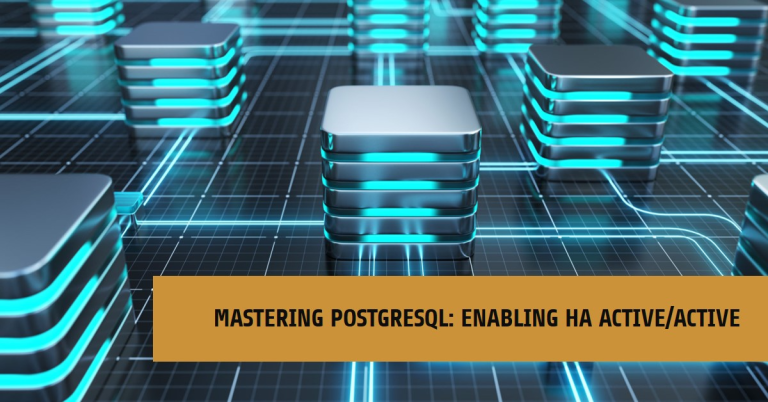Active/active replication in PostgreSQL enhances both high availability and load balancing. This advanced setup uses the Bi-Directional Replication (BDR) plugin to synchronize multiple database servers. Here’s how to set it up.
Table of Contents
Setting Up Active/Active Replication
Step 1: Prepare the Servers
Ensure you have at least two servers with PostgreSQL installed. Both servers must run the same PostgreSQL version.
Step 2: Install the BDR Plugin
Since the BDR plugin is not part of PostgreSQL’s standard distribution, download and install it separately. This typically requires downloading the source code and compiling it on each server.
Step 3: Update PostgreSQL Configuration
Edit the postgresql.conf file to enable BDR. Key changes include:
- Set
shared_preload_librariesto includebdr. - Adjust
wal_level,max_wal_senders, andmax_replication_slotsas needed. - Configure
track_commit_timestampwith thebdr.bdr_part_by_node_namesparameter.
Step 4: Modify pg_hba.conf
Update the pg_hba.conf file to permit connections between servers in the BDR group.
Step 5: Create the BDR Group
On the first server, create a database and activate BDR using the bdr.bdr_group_create function. This initializes the BDR group with a single member.
Step 6: Add Additional Servers
On the second server, create an identical database and join it to the group using the bdr.bdr_group_join function. Provide the connection string for the first server’s database.
Step 7: Verify the Setup
Run bdr.bdr_nodes and bdr.bdr_connections on any server to confirm replication status across the group.
Note: These steps provide a general guide. The exact process may vary depending on your PostgreSQL version and server setup. Refer to the official BDR documentation for details.
Advantages and Challenges of Active/Active Replication
Active/active replication ensures high availability and better load distribution. If one server fails, the other continues seamlessly, keeping your data accessible. Additionally, read queries can be split between servers, speeding up response times and enhancing performance.
This setup is also ideal for global operations. Users connect to the nearest database server, reducing latency and improving their experience. Real-time data synchronization ensures all servers remain up-to-date.
However, this approach has its complexities:
- Setup and Maintenance: Configuring and managing active/active replication requires advanced skills. Regular monitoring is necessary.
- Conflict Resolution: Data conflicts can arise when changes occur on multiple servers simultaneously. BDR offers conflict resolution tools, but selecting the right strategy demands a clear understanding of your data patterns.
- Increased Resource Needs: Managing this setup demands more time, expertise, and resources. Errors can lead to critical issues.
Load Balancing Strategies for Active/Active Setups
Effective load balancing is crucial for distributing workloads across servers. Popular tools include:
- Pgpool-II: Understands SQL queries, directing read operations to different servers.
- HAProxy: Operates at the TCP level to distribute connections but lacks SQL understanding.
Load balancers must also manage node failures and handle new connections efficiently to ensure smooth operation.
Conflict Resolution Techniques in PostgreSQL Active/Active Replication
Conflicts are common in PostgreSQL active/active replication setups, especially when multiple servers handle write operations simultaneously. The Bi-Directional Replication (BDR) plugin provides tools to detect and resolve these conflicts effectively.
Common Conflict Resolution Strategies
- Last Update Wins
The most recent change is accepted, and earlier conflicting changes are discarded. While simple, this method can overwrite critical updates in environments with high transaction rates. - First Update Wins
The first change received is preserved, and later conflicting changes are ignored. This approach minimizes overwrites but may discard important updates. - Rollback Transactions
Conflicts trigger a rollback of one transaction while allowing the other to proceed. The rolled-back transaction can be retried. Though effective, this requires careful implementation to manage retries and consistency. - Custom Conflict Handlers
Define rules tailored to your data and use cases for resolving conflicts. This flexible option is ideal for complex or unique scenarios.
Selecting a conflict resolution strategy depends on the nature of your data, transaction frequency, and tolerance for potential data loss or overwrites.

Performance Optimization Tips for PostgreSQL
Enhancing PostgreSQL performance involves fine-tuning configurations, queries, and maintenance practices.
- Database Tuning: Adjust memory settings in
postgresql.conf, such asshared_buffersandwork_mem. - Query Optimization: Use
EXPLAIN ANAYLZEto identify inefficient queries and improve them. - Indexes: Apply indexes strategically to speed up reads but monitor their impact on write performance.
- Performance Logging: Enable logs to track query execution times and resource usage.
- Vacuuming: Regularly run or enable auto-vacuum to clean up dead tuples and maintain optimal performance.
Failover and Disaster Recovery in PostgreSQL
Failover and disaster recovery are vital for data protection and service continuity during failures or disasters.
Failover Mechanism
Failover ensures uninterrupted service when a server fails. In a replication setup, a standby server takes over if the primary server goes down. Tools like Replication Manager (repmgr) or Patroni automate this process by monitoring server health and promoting a standby when needed.
Heartbeats play a key role here. Standby servers rely on regular signals from the primary. If these stop, the standby assumes the primary is down and steps in.
Disaster Recovery
Disaster recovery focuses on restoring data and operations after significant failures. Point-In-Time Recovery (PITR) is a PostgreSQL feature that allows you to restore your database to a specific moment using backups and transaction logs.
Here’s how it works:
- Start with the latest base backup.
- Apply changes recorded in Write-Ahead Logs (WALs) up to the recovery point.
Tools like pg_basebackup (for backups) and pg_receivewal (for streaming WALs) are essential for implementing PITR. For success, you need a solid backup strategy and secure storage for WAL files.
Both failover and disaster recovery are crucial for high availability and data protection. By implementing these mechanisms, you can minimize downtime and safeguard critical information.
Frequently Asked Questions (FAQ)
Does Ubuntu support PostgreSQL High Availability (HA)?
Yes, Ubuntu does support PostgreSQL High Availability (HA). High Availability can be achieved in PostgreSQL through various techniques, such as streaming replication, logical replication, and the use of certain extensions like Postgres-BDR (Bi-Directional Replication).
Is BDR officially supported by PostgreSQL?
Bi-Directional Replication (BDR) is not officially supported by the PostgreSQL Global Development Group, the community of developers behind PostgreSQL. BDR is a third-party extension developed by 2ndQuadrant, a company specializing in PostgreSQL technologies.
Does BDR supported on Windows?
The Bi-Directional Replication (BDR) extension for PostgreSQL does not officially support Windows. BDR is primarily designed for Linux-based systems.

